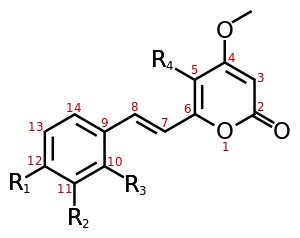Kavalactone

Kavalactones are a class of lactone compounds found in the kava shrub. Kavalactones have a wide variety of effects including amnestic, analgesic, anticonvulsant, anxiolytic, nootropic, and sedative/hypnotic activity caused by numerous interactions with the central nervous system via several mechanisms.
Enzyme inhibition
Kava extract has been shown to potently inhibit a wide range of hepatic enzymes, suggesting a very high potential for interactions with many pharmaceuticals and herbal medications.[1] For this reason, kava should never be consumed without the permission of a primary care physician, psychiatrist, and/or any other doctor who is prescribing medication for a patient. It is also recommended that potential users discuss their kava use with a pharmacist. If undergoing anesthesia, it is recommended to note any use of kava well in advance of any surgery. Patients may be instructed to temporarily discontinue use of kava for a set period of time before and after the surgery.
Toxicity
Several kavalactones (e.g.Methysticin and Yangonin) have been reported to induce activity of CYP1A1. Hepatoxicity has been reported in a small portion of previously healthy kava users, particularly of extracts as opposed to whole root powders.[2][3]
Numerous kavalactones have apoptotic effects on various human tissues, which may be involved in some of the purported toxic effects of kava use.[4][5][6]
Compounds
At least 18 different kavalactones have been identified to date, with methysticin being the first identified.[7] Multiple analogues, such as ethysticin, have also been isolated.[8] Some consist of a substituted α-pyrone as the lactone while others are partially saturated.
The average elimination half-life of kavalactones typically present in kava root is 9 hr.[9]
| Name | Structure | R1 | R2 | R3 | R4 |
|---|---|---|---|---|---|
| Yangonin | 1 | -OCH3 | -H | -H | -H |
| 10-methoxyyangonin | 1 | -OCH3 | -H | -OCH3 | -H |
| 11-methoxyyangonin | 1 | -OCH3 | -OCH3 | -H | -H |
| 11-hydroxyyangonin | 1 | -OCH3 | -OH | -H | -H |
| Desmethoxyyangonin | 1 | -H | -H | -H | -H |
| 11-methoxy-12-hydroxydehydrokavain | 1 | -OH | -OCH3 | -H | -H |
| 7,8-dihydroyangonin | 2 | -OCH3 | -H | -H | -H |
| Kavain | 3 | -H | -H | -H | -H |
| 5-hydroxykavain | 3 | -H | -H | -H | -OH |
| 5,6-dihydroyangonin | 3 | -OCH3 | -H | -H | -H |
| 7,8-dihydrokavain | 4 | -H | -H | -H | -H |
| 5,6,7,8-tetrahydroyangonin | 4 | -OCH3 | -H | -H | -H |
| 5,6-dehydromethysticin | 5 | -O-CH2-O- | -H | -H | |
| Methysticin | 7 | -O-CH2-O- | -H | -H | |
| 7,8-dihydromethysticin | 8 | -O-CH2-O- | -H | -H | |
 Structure 1 |
 Structure 2 |
 Structure 3 |
 Structure 4 |
 Structure 5 |
 Structure 6 |
 Structure 7 |
 Structure 8 |
See also
References
- ↑ James M. Mathews; Amy S. Etheridge; Sherry R. Black. "Inhibition of Human Cytochrome P450 Activities by Kava Extract and Kavalactones".
- ↑ Joji Malani (2002). "Evaluation of the effects of Kava on the Liver" (PDF). Retrieved 2008-01-05.
- ↑ AC Brown (2007). "Traditional kava beverage consumption and liver function tests in a predominantly Tongan population in Hawaii revealed no liver impairment.". Retrieved 2009-03-17.
- ↑ Tang, J; Dunlop, RA; Rowe, A; Rodgers, KJ; Ramzan, I (2010). "Kavalactones Yangonin and Methysticin Induce Apoptosis in Human Hepatocytes (HepG2) In Vitro.". Phytotherapy research : PTR. 25 (3): n/a. doi:10.1002/ptr.3283. PMID 20734326.
- ↑ Zi X, Simoneau AR (April 2005). "Flavokawain A, a novel chalcone from kava extract, induces apoptosis in bladder cancer cells by involvement of Bax protein-dependent and mitochondria-dependent apoptotic pathway and suppresses tumor growth in mice.". Cancer Research. 65 (8): 3479–86. doi:10.1158/0008-5472.CAN-04-3803. PMID 15833884.
- ↑ Ramez NE, Leslie M, Randall TS, Yi G, Bang H, Xiaolin Z. "Flavokawain B, a novel, naturally occurring chalcone, exhibits robust apoptotic effects and induces G2/M arrest of a uterine leiomyosarcoma cell line".
- ↑ Naumov, P.; Dragull, K.; Yoshioka, M.; Tang, C.-S.; Ng, S. W. (2008). "Structural Characterization of Genuine (-)-Pipermethystine, (-)-Epoxypipermethystine, (+)-Dihydromethysticin and Yangonin from the Kava Plant (Piper methysticum)". Natural Product Communications. 3 (8): 1333–1336.
- ↑ Shulgin, A. (1973). "The narcotic pepper - the chemistry and pharmacology of Piper methysticum and related species". Bulletin on Narcotics. UNODC (2): 59–74.
- ↑ www.sigmaaldrich.com/life-science/nutrition-research/learning-center/plant-profiler/piper-methysticum.html